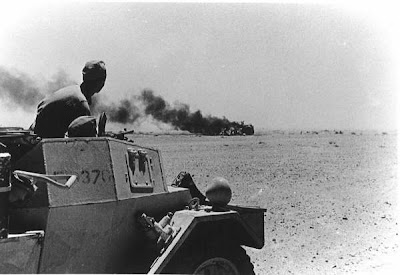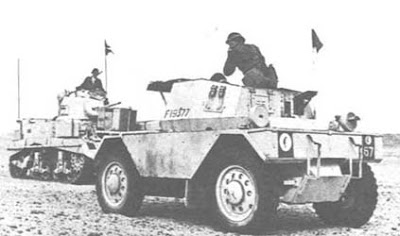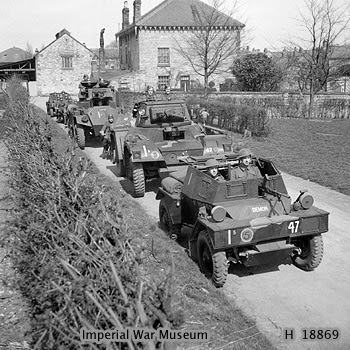It is funny how things work out sometimes.
I am a big fan of reading about armored cars and other types of scouting vehicles from the WW2 era. There have been millions of pages written about the famous tank battles like Kursk. On top of that, there are many, many picture books that feature WW2 tanks. A few subjects that don’t get quite as much attention are armored cars, scout vehicles, and transports. Heck, Patton once said that his greatest weapon was the good old two ton truck.
Carl and I for a long time played a WW2 simulation game (we really should start again) and it was very refreshing to see a pretty good selection of scout cars that were available for us to choose. I sort of fell in love with two, the Greyhound and the Daimler Dingo. In our simulation games, Carl and I would use these vehicles as sacrificial lambs, and send them forward quickly to discover hidden gun emplacements, tanks, trenches or whatever the enemy had in store. From receiving this information, we could shell the targets with artillery, mortars, tank fire, or whatever was required to eliminate the target. Most often these scouts were blown up pretty quickly if they stumbled upon a main battle tank, but that was OK as the information was worth more to us than the vehicle itself, or the computer generated men inside.
Several months ago one of my co-bloggers at LITGM (and former ChicagoBoyz commenter) Frank Borger passed away suddenly. He was in the middle of a series of posts about warbirds. He was scanning photos from airshows he attended some 20 years ago. Included in this series of posts was this one. Here is the second photo from that post – Daimler Dingo!

In the comments to that post I made a few erroneous statements, corrected by one “Singe”. “Singe” left his comment more than six months after the original post. It is worth reproducing here:
Hi, I’m lucky enough to own one of these vehicles.
As for your comment much too slow… i think not. The dingo can do 60mph forward and 55mph in reverse. It handles really well on rough ground due to the very advanced fully independent coiled spring suspension and permanent 4WD. The real Desert Rats, the 7th armoured division and Recce corps used them. Anything so unprotected as a jeep would not have lasted very long in the exposed western desert if used in front of the front-lines as these vehicles were.
The car was normally armed with a Boyes anti tank rifle but more commonly a BREN gun or rarely twin Lewis or Vickers machine guns. Daimler in the 1930’s was a wholly English company and was part of the BSA group. It was not connected with the German Daimler-Benz. This was just as well as we would not have wanted the ‘Jerries’ to have a direct feed into our biggest arms manufacturer!
If you’re interested I can provide some really good wartime photo’s of the cars in action. Regards, Singe
I emailed him (I believe he is from Australia or England) and thanked him for commenting and asked him for more photos. He sent some back and here they are, presented with the captions he provided. I asked him if it was OK for me to identify him on the internet but never heard back so he will have to remain anonymous for now.
The power of Google amazes me daily.

The Daimler ‘Dingo’ Scout Car and its big brother (that was introduced slightly latter) the Daimler Armoured Car armed with a 35mm main gun.

The commander and gunner of a Dingo cautiously approach a damaged German vehicle somewhere in the western desert circa 1942-3. Bren gun at the ready.

Dingos were commonly used in both the reconnaissance role, well out in front of heavier armour to observe the location of enemy troops or in the liaison role for commanding officers of tank regiments.

A Convoy of vehicles lead and tailed by scout cars of the 27th Lancers, Italy 1944.
A photo of my Dingo, she’s painted in the colours of the 2nd Regiment of the Household Cavalry, part of VIII Corps of the 21st British Army Group circa 1944, this was the regiment in which my grandfather fought in WW2. The car was manufactured in January 1944 and it is thought that it would have served in the battle for the liberation of NW Europe subsequent to D-day.
Unfortunately most of the historic vehicle records were destroyed in the mid 1960’s and so it is almost impossible to trace the exact service history of an individual vehicle.
The stars are commonly thought to be American Stars, this is not however the case. After 1944 all vehicles were given ‘Allied forces stars’ as a recognition aid.
Cross posted at LITGM.
The dingo can do 60mph forward and 55mph in reverse.
Seems to me that a scouting vehicle should go faster in reverse than forward but maybe thats just me.
Hi
My wife is researching her father’s war. Her dad Harry Rose was a Dingo driver in 2HCR D squadron 4 troop. His car commander was Corporal of Horse Bugby. They were the last of the original 2HCR dingos to be destroyed at Sittensen near Hamburg in April 1944. Fortunately both survived being blown up by a Schu mine, testament to the strength of the Dingo. I would love to see a front photo of the Household Cavalry colour scheme or share any stories with anyone who had serving relatives in 2HCR
Dear Mr B.
im the owner of the Dingo pictured above and have a great deal of information regarding the 2HCR, please feel free to contact me at ‘singeager@hotmail.com’
If you would like a have a ride in the car, which is HCR markings by the way, this may be possible….
regards